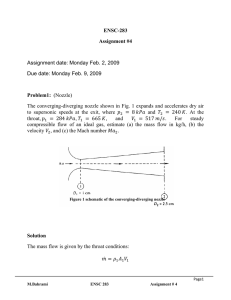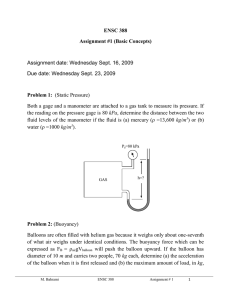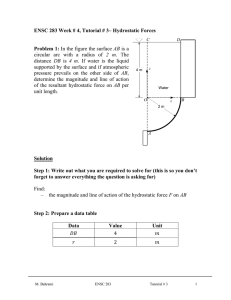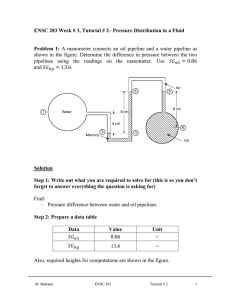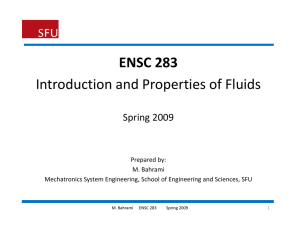Quiz 1_solution
advertisement
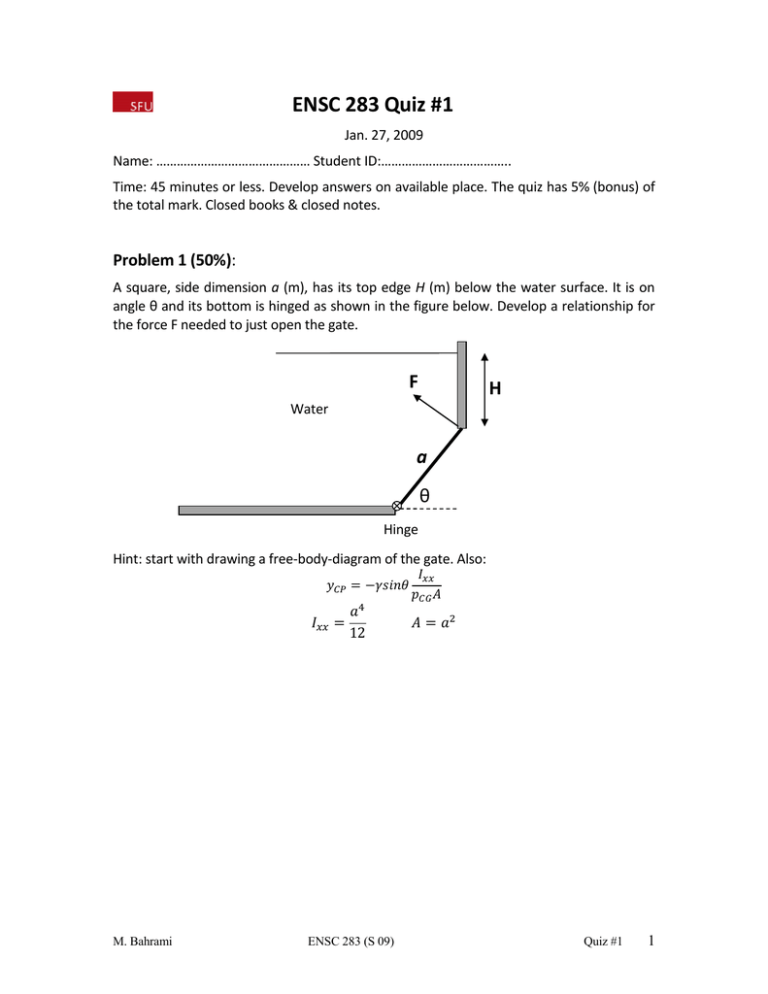
ENSC 283 Quiz #1 Jan. 27, 2009 Name: ……………………………………… Student ID:……………………………….. Time: 45 minutes or less. Develop answers on available place. The quiz has 5% (bonus) of the total mark. Closed books & closed notes. Problem 1 (50%): A square, side dimension a (m), has its top edge H (m) below the water surface. It is on angle θ and its bottom is hinged as shown in the figure below. Develop a relationship for the force F needed to just open the gate. F H Water a θ Hinge Hint: start with drawing a free-body-diagram of the gate. Also: 𝑦𝐶𝑃 = −𝛾𝑠𝑖𝑛𝜃 𝐼𝑥𝑥 M. Bahrami 𝑎4 = 12 ENSC 283 (S 09) 𝐼𝑥𝑥 𝑝𝐶𝐺 𝐴 𝐴 = 𝑎2 Quiz #1 1 Solution: The first step is to sketch a free-body diagram of the gate so the forces and distances are clearly identified. It is done in the following figure. H F FR . CG |𝑦𝐶𝑃 | θ Fx Fy The force 𝐹𝑅 is calculated to be 𝐹𝑅 = 𝛾ℎ𝐶𝐺 𝐴 = 𝛾(𝐻 + 𝑎 sin 𝜃 2 (Eq.1) )𝑎2 We will take moments about the hinge so that it will not be necessary to calculate the forces 𝐹𝑥 and 𝐹𝑦 . 𝑎 (Eq.2) 𝐹𝑅 × [2 − |𝑦𝐶𝑃 |] = 𝐹 × 𝑎 where, |𝑦𝐶𝑃 | is the distance between the center of pressure (CP) and the center of gravity (CG). |𝑦𝐶𝑃 | can be written as: |𝑦𝐶𝑃 | = 𝛾𝑠𝑖𝑛𝜃 M. Bahrami 𝐼𝑥𝑥 𝐼𝑥𝑥 sin 𝜃 𝑎4 sin 𝜃 𝑎2 sin 𝜃 = = = 𝑝𝐶𝐺 𝐴 ℎ𝐶𝐺 𝐴 12 (𝐻 + 𝑎 sin 𝜃)𝑎2 12(𝐻 + 𝑎 sin 𝜃) 2 2 ENSC 283 (S 09) Quiz #1 (Eq.3) 2 Substituting |𝑦𝐶𝑃 | into Eq.2, the force F is found. 𝐹= 𝑎 𝐹𝑅 × [2 − |𝑦𝐶𝑃 |] 𝑎 = 𝛾(𝐻 + 𝑎 sin 𝜃 2 𝑎 |𝑦 |] 2 )𝑎 [2 − 𝐶𝑃 𝑎 (Eq.4) Simplifying the above equation, we get: 𝐹= M. Bahrami 𝛾𝑎2 (3𝐻 + 𝑎 sin 𝜃) 6 ENSC 283 (S 09) (Eq.5) Quiz #1 3 Problem 2 (50%): It is said that Archimedes discovered the buoyancy laws when asked by King Hiero of Syracuse to determine whether his new crown was pure gold (SG = 19.3). Archimedes measured the weight of the crown in air to be 11.8 N and its weight in water to be 10.9 N. Was it pure gold? Hint: the buoyancy is the difference between air weight and underwater weight. 𝐹𝐵 = 𝛾𝑉 Solution: The buoyancy is the difference between air weight and underwater weight: (Eq.1) 𝐹𝐵 = 𝑊𝑖𝑛 𝑎𝑖𝑟 − 𝑊𝑖𝑛 𝑤𝑎𝑡𝑒𝑟 = 𝛾𝑤𝑎𝑡𝑒𝑟 𝑉𝑐𝑟𝑜𝑤𝑛 = 11.8 𝑁 − 10.9 𝑁 = 0.9 𝑁 where, 𝑊𝑖𝑛 𝑎𝑖𝑟 and 𝑊𝑖𝑛 𝑤𝑎𝑡𝑒𝑟 are the weight of the crown in air and water, respectively. The weight of the crown in air can be expressed as: 𝑊𝑖𝑛 𝑎𝑖𝑟 = (𝑆𝐺)𝛾𝑤𝑎𝑡𝑒𝑟 𝑉𝑐𝑟𝑜𝑤𝑛 (Eq.2) Substituting Eq.2 into Eq.1, we get: 𝑊𝑖𝑛 𝑤𝑎𝑡𝑒𝑟 = 𝛾𝑤𝑎𝑡𝑒𝑟 𝑉𝑐𝑟𝑜𝑤𝑛 (𝑆𝐺 − 1) = 𝐹𝐵 (𝑆𝐺 − 1) (Eq.3) Thus, the specific gravity of the crown can be written as: 𝑆𝐺 = 1 + M. Bahrami 𝑊𝑖𝑛 𝑤𝑎𝑡𝑒𝑟 𝐹𝐵 =1+ 10.9 0.9 (Eq.4) = 𝟏𝟑. 𝟏𝟏 (𝒏𝒐𝒕 𝒑𝒖𝒓𝒆 𝒈𝒐𝒍𝒅) ENSC 283 (S 09) Quiz #1 4

